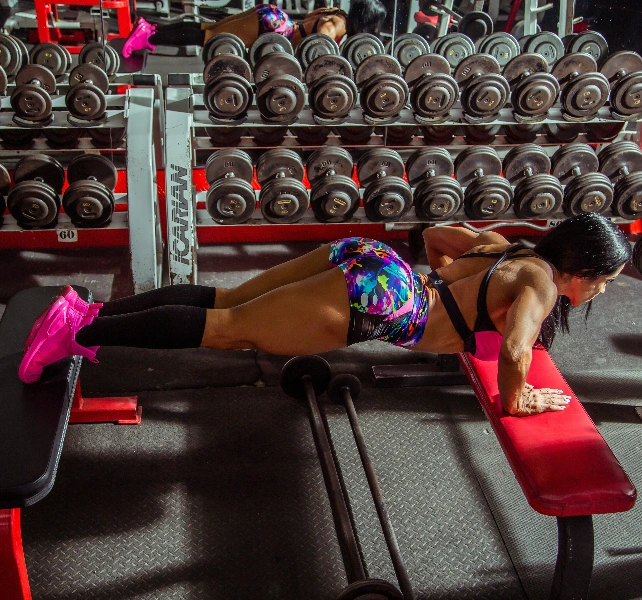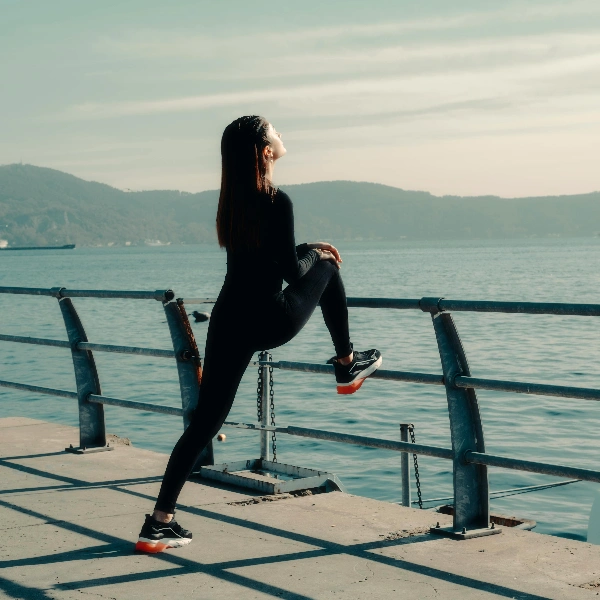Compression gear during a workout, commonly called pneumatic compression devices, is specialized compression therapy equipment for a healthier exercise goal. They play a pivotal role in maintaining blood flow during hard and vigorous workout schedules.
Just as the name indicates, compression exercise equipment is tailored in such a way that it applies light pressure on the designated body part, improving vascular flow throughout the body.
Moreover, there are multiple other benefits of wearing compression equipment during exercises. Keep reading this article till the end, as it mainly aims to unveil the different aspects of compression exercise equipment. So, let’s dive into the debate!

Credit @Andrea Piacquadio on Pexels
What Is Compression Gear?
Compression gear, also known as compression exercise equipment, is an outfit specially designed to be worn during workout sessions, which tightly fits your skin.
Such outfits are elastic, usually made of spandex or any other elastic fiber, which is the main element in providing compression to the muscles. They are well known for their supportive and enhancing capabilities, making your workout routines enjoyable and safe.

Photo by Gabin Vallet | Unsplash
Different Types of Compression Gear
Compression gear is of different types, depending upon the body part where it is used. Here are some common and useful compression gear during workouts.

Photo by Carl Barcelo | Unsplash
Compression Socks or Stockings
Compression socks are particularly worn on the legs and feet. Runners and athletes looking to enhance their athletic performances and recovery usually use this form of compression gear.
These socks are designed to apply even pressure throughout the leg muscles. This gentle compression helps to improve overall blood circulation in the legs, which can reduce muscle fatigue, cramping, and soreness across the entire leg area. The gradual decrease in pressure from the ankle upwards is intended to aid in the return of blood to the heart, providing support and relief for the leg muscles during and after physical activity.
Not only this, but they also help to reduce the risk of varicose veins and deep venous thrombosis, and also maintain venous pressure within the legs.

Credit @Sabel Blanco on Pexels
Compression Sleeves
Compression sleeves are designed to be worn particularly on arms but can sometimes be worn on calf muscles as well.
They could be either arm sleeves or calf sleeves. They provide graduated pressure on the respective muscles, which gradually decreases in moving up (for instance, from the wrist to the upper arm or from the ankle to the thigh).

Compression Shorts
Compression Shorts, as their name implies, apply pressure on the thigh and the groin area. They are most efficacious during extensive leg workouts, keeping your thigh muscles intact and tight.

Compression Tops or Shirts
Compression shirts are tailored for compression of the upper body. Other than providing support during the upper body workout, they are also effective in maintaining correct posture during exercise.

Compression Tights or Leggings
They cover the whole lower limb, including the groin region, thigh, and calf muscles. Compression tights are best during long runs and yoga positions.

Credit @Alexy Almond on Pexels
Compression Suits for Full Body
They provide support and compression to the whole body during exercises that involve both upper and lower body movements.

Photo by Gabin Vallet | Unsplash
Understanding the Role of Compression during Exercise
Compression during exercise has gained vast popularity among the gym-going guys and athletes nowadays, who are crazy and enthusiastic for the best of their fitnesses.
Understanding and demystifying the role of compression during exercise makes it clear how compression gear equipment increases athletic performance.

Credit to GRAHAM MANSFIELD | Unsplash
During exercise, our body undergoes several temporary changes within the circulatory system. It is because whenever we exercise, the body’s demands increase, and as a result of this, the supply system also undergoes adaptive changes to cope with the needs of the body. Not only this, but hard-core exercises can also lead to muscle soreness, fatigue, muscle cramps, and many more such issues.
However, compression gear, when used effectively, not only improves circulatory issues during exercise but also helps in relieving muscle soreness and fatigue.
Compression gear does so by applying gentle pressure to the directed body part, which helps prevent blood pooling or venous stasis within that part and also assists in relieving the associated discomforts.
In this way, compression during exercise can enhance athletic fitness up to a thousandfold.
Benefits of Wearing Compression Gear during Exercise
Compression gear has shown vast improvement in the athletic performance of several athletic enthusiasts. There are several benefits of wearing compression gear during exercise:

Improved Blood Circulation in the Targeted Muscle Groups
Compression gear improves circulation within the targeted muscle groups and offers several benefits to the body:
- Improved circulation leads to increased oxygen delivery to the muscle tissues, which ensures enhanced performance and athletic endurance during the workouts.
- Proper blood flow leads to proper waste removal from the tissues during increased energy demands, which in turn helps to reduce muscle fatigue.
Decreased Muscular Oscillations/ Vibrations Leads To Reduced Muscle Soreness
Intense workouts cause muscular oscillations and vibrations of the muscle tissues, which can cause muscle fatigue and trauma to the tissues. It ultimately can lead to muscle soreness.
Compression gear also helps to get rid of it by preventing vibratory movements of the muscles through graduated compression, thus reducing the chances of microtrauma and muscle soreness.
Enhanced Muscular Support
Compression garments play a pivotal role in keeping the muscles reinforced, supported, and aligned to their perfect positions. In this way, it provides enhanced muscle support, which reduces the risks of muscle strains, cramps, or sprains.
Homeostasis through Thermoregulation and Pressure Maintenance
Exercise generates great amounts of heat within the body, which can cause muscular strains.
However, compression gear also assists in thermoregulation by maintaining consistent pressure. It helps to keep the muscles regulated with balanced temperature and pressure, thus reducing the chances of muscle strains.
Reduced Risks of Injury
Compression gear keeps the joints and muscles well-stabilized in their positions. Effective stabilization of the joints and muscles plays a significant role in reducing the risks of associated injuries.
How to Effectively Choose the Right Compression Gear for Your Body?
Choosing the right compression gear for yourself is the most significant step to enjoying the benefits of wearing compression gear during exercise. Take care of the following things while selecting the correct compression gear:

Photo by LOGAN WEAVER | @LGNWVR | Unsplash
- Select the best quality fabric. Make sure it is elastic and perfectly breathable.
- Select the correct size for yourself. Ensure that your compression gear is not too tight or pressing into your skin. However, it should fit your body without causing any discomfort.
- Choose the type of compression gear according to your desired targeted body part.
- Follow the wearing tips mentioned in the manufacturer’s instructions.
- Take care of the proper hygiene of your compression gear.
- Follow the care tips for your compression gear as mentioned in the manufacturer’s instructions.
FAQs about Compression Equipment

Credit @Wolrider YURTSEVEN on Pexels
1. What does compression equipment do?
As we have already discussed, compression equipment is a specialized garment designed to apply pressure (compression) on the targeted body part or muscle groups and worn during your exercise schedules.
2. Does compression help with pain?
Yes! Compression helps to alleviate pain and discomfort. Compression helps to enhance blood circulation, which as a result, leads to increased oxygen supply and nutrient delivery to the targeted tissues. It also leads to a faster metabolic waste removal rate.
All of these mechanisms altogether help to create a sensation of comfort and relief from the pain caused during exercise.
3. Is compression good for nerves?
Yes! Compression is good for nerves as the pressure exerted by compression gear provides enhanced sensory feedback to the brain.
However, severe nerve compression can also lead to severe muscular damage. So, it is always best to consult your healthcare provider before opting for compression equipment if you have any neuropathies.
4. Does compression help you run faster?
Yes! Compression helps to remove metabolic products, like lactic acid, faster from the body. It will then help to reduce muscle fatigue during running. Thus, scientifically, compression will help you run faster and better.
5. Is compression gear good for working out?
Yes! Compression gear is extremely good for working out as it not only improves blood flow within the body but also improves athletic endurance and support during exercises.
6. What are the positive effects of compression garments?
There are several positive effects of compression garments. They improve blood flow, reduce muscle oscillations, reduce the risks of microtrauma, reduce muscle soreness and fatigue, enhance athletic performance, and reduce the risks of injury during exercises.

Photo by Jonathan Borba | Unsplash
The Final Thoughts
Compression exercise equipment or compression gear is a specialized outfit tailored to apply gentle pressure on the body through its compressive properties during workouts.
These outfits are of various types according to their body parts, like compression sleeves, compression tights, compression tops, compression shorts, and even full-body compression suits.
Nevertheless, compression gear serves incredible benefits to your body, which include improved blood flow, enhanced athletic endurance, metabolic waste removal, muscle support, decreased muscle fatigue, decreased soreness, and reduced risks of muscular trauma or injuries.
Therefore, compression gear has gained immense popularity among the crazy athletes in today’s world.
However, it is always best to consult your physician before opting for compression gear for long-term use, as it can sometimes also lead to nerve damage or muscular spasms.
Hope we have got you all covered. Stay stronger and healthy!



